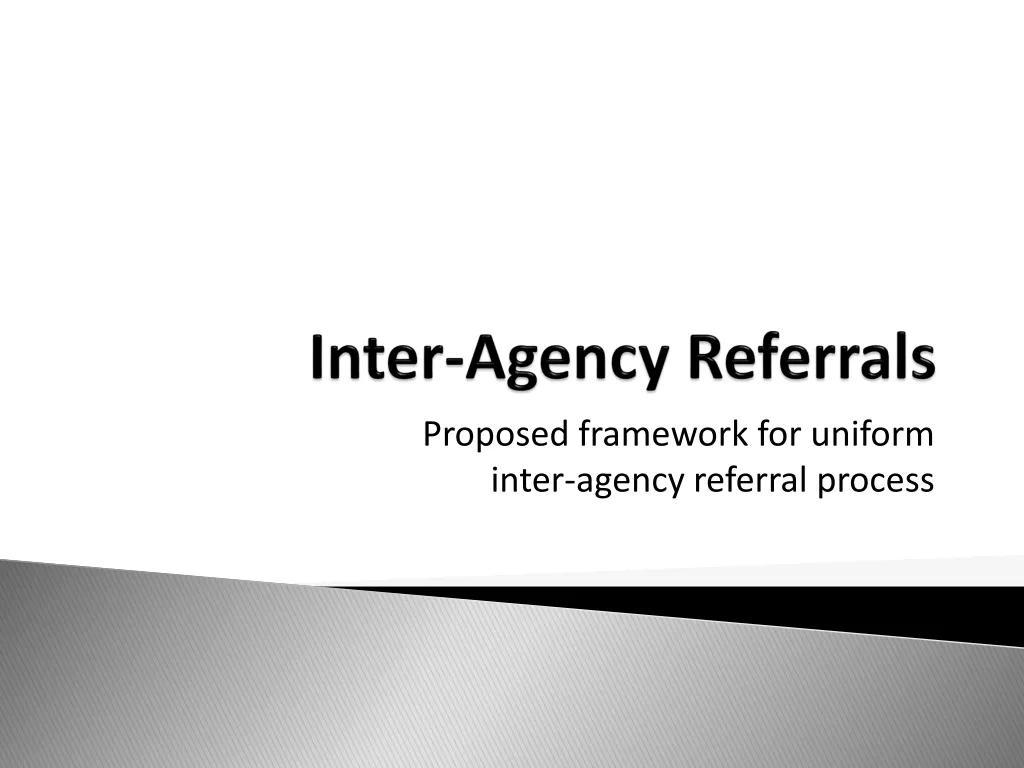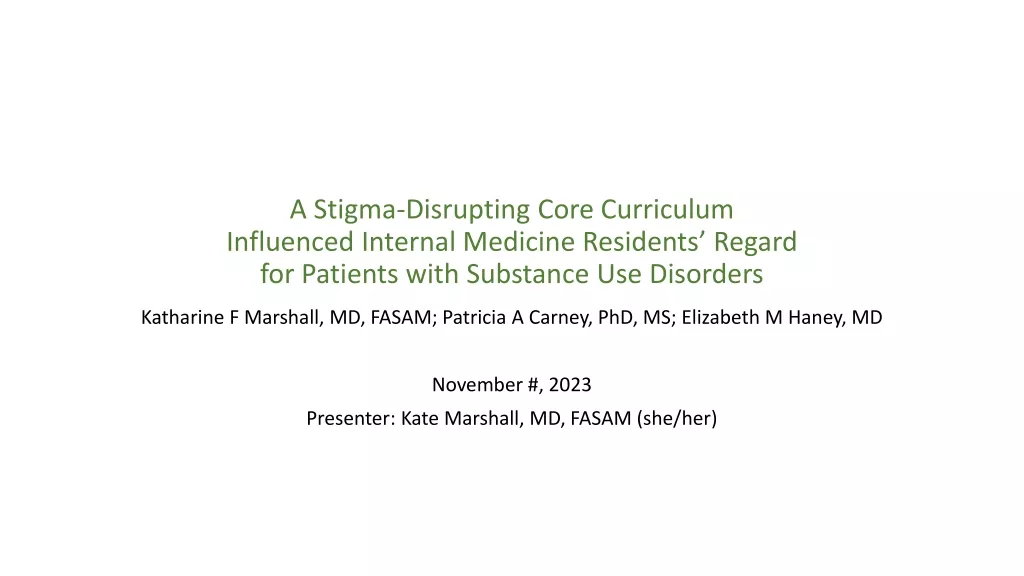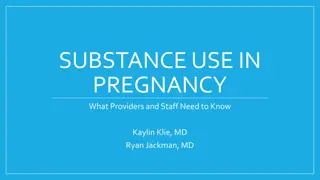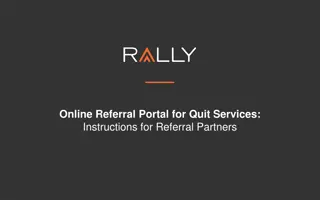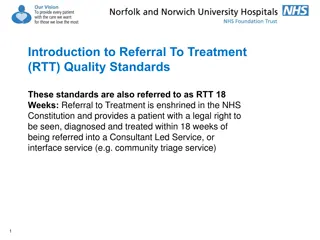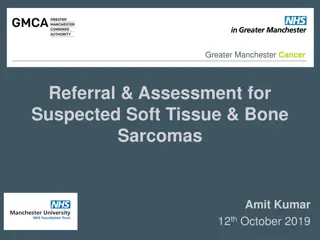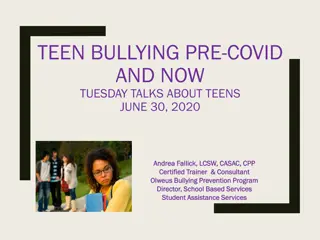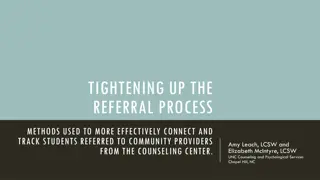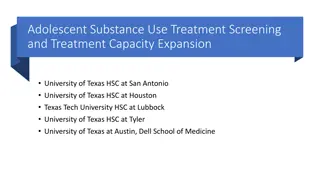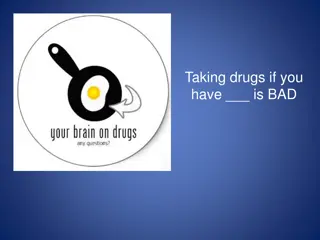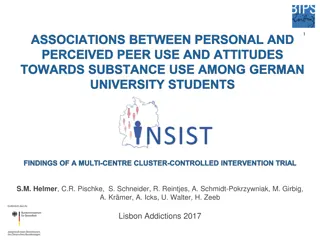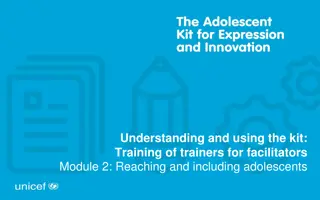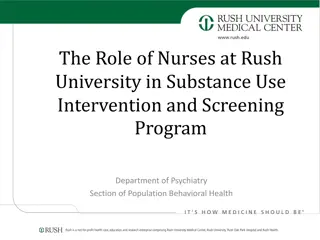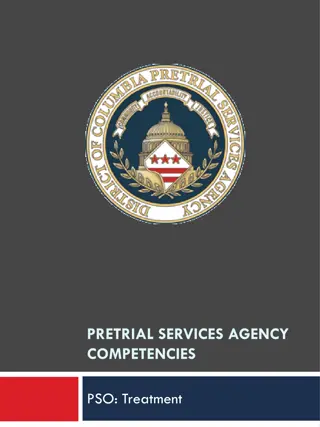Adolescents Substance Use Treatment Referral and Follow-up
Explore the process of referring adolescents to substance use treatment, addressing challenges like confidentiality and push back. Understand treatment options, warm hand-offs, and the importance of follow-up. Discover suggested readings and data on adolescents admitted to substance abuse treatment, highlighting the need for effective referral systems.
Download Presentation

Please find below an Image/Link to download the presentation.
The content on the website is provided AS IS for your information and personal use only. It may not be sold, licensed, or shared on other websites without obtaining consent from the author.If you encounter any issues during the download, it is possible that the publisher has removed the file from their server.
You are allowed to download the files provided on this website for personal or commercial use, subject to the condition that they are used lawfully. All files are the property of their respective owners.
The content on the website is provided AS IS for your information and personal use only. It may not be sold, licensed, or shared on other websites without obtaining consent from the author.
E N D
Presentation Transcript
Module 4 Referral to Treatment and Follow-up
Presenters & Acknowledgements PRESENTERS ACKNOWLEDGEMENTS This module is based on materials from the Adolescent SBIRT Learner s Guide developed by NORC at the University of Chicago with funding from the Conrad N. Hilton Foundation. Text: TBD Subtext: TBD Text: TBD Subtext
Learning Objectives 1. Learn which substance use disorder treatment options are best suited to address the needs of adolescents. 2. Understand unique challenges that you will encounter when referring adolescents to treatment, relating to confidentiality and push back. 3. Recognize what constitutes a warm hand-off when referring adolescents to treatment. 4. Understand the importance of follow-up and learn what to cover during these encounters.
Suggested Readings National Institute on Drug Abuse. Principles of Adolescent Substance Use Disorder Treatment: A Research-based Guide. Bethesda, MD: NIDA; 2014. Williams RJ, Chang SY. A comprehensive and comparative review of adolescent substance abuse treatment outcome. Clinical Psychology: Science and Practice. 2000;7(2):138-166. Meyers K, Cacciola J, Ward S, Kaynak O, Woodworth A. Paving the Way to Change: Advancing quality interventions for adolescents who use, abuse or are dependent upon alcohol and other drugs. Philadelphia, PA: Treatment Research Institute; 2014. Winters KC, Tanner-Smith EE, Bresani E, Meyers K. Current advances in the treatment of adolescent drug use. Adolescent Health, Medicine and Therapeutics. 2014;5:199.
When to Refer Adolescents to Substance Use Treatment A very small number of adolescents will require a level or intensity of treatment beyond that of which you may be able to provide. Specialty substance abuse treatment may be necessary. In 2013, 1.3 million youth age 12-17 were in need of treatment, but only 122,000 (9.1%) received it at a specialty facility. Adolescents must agree to participating in treatment. How you broach and discuss referral contributes to the likelihood of successful treatment. In contrast to adults, adolescents are less likely to feel that they need help or seek treatment on their own.
Number of Adolescents Admitted to Substance Abuse Treatment This chart grouped the number of admittances by referral sources, according to the 2008 Treatment Episodes Data Set (TEDS) analysis majority are being referred through the juvenile justice system. many more who are being missed. Through SBIRT, adolescents in need of treatment can be identified and given the information they need to enter treatment from school, medical and community sources.
When Working with Adolescents Adolescents have a harder time recognizing their own behavior patterns than adults. Young Shorter histories of substance use Unlikely adverse consequences of use Less incentive to change or begin treatment. Depending on the age of the adolescent, the degree of acute risk, and state regulations regarding access to health care by a minor, it may be necessary to involve the parents/guardians of the adolescent regardless of whether the adolescent consents. Breaking confidentiality in this situation can be challenging. Be familiar with legal issues associated with maintaining and breaking confidentiality. Resistance and denial (lack of insight) are characteristic of substance use disorders at this stage of the disease, therefore the adolescent and/or family may be unwilling to pursue treatment even when it is clearly indicated. Motivational Interviewing strategies can be used to encourage an adolescent and/or family to accept a referral.
Benefits of Early Referral to Treatment NIDA indicates that adolescents can benefit from substance abuse interventions, regardless of their level of use since any amount of substance use is concerning. Substance use is associated with increased risk of motor vehicle accidents, other injuries, and unwanted pregnancy and contraction of sexually transmitted diseases (STDs) as a result of sexual risk taking, all of which can be a consequence of first time use. Adolescent use is also associated with increased risk of chronic disease, poor school performance, depression, suicide and future dependence. Referrals or handoffs for any additional treatment can be challenging, particularly, when working with individuals with substance use problems, however, handoffs are extremely important According to a 2004 Treatment Episode Data Set (TEDS) analysis of adult populations (age 18 and older), only 16% of clients discharged from detoxification programs start a new level of care. Only 30% of clients discharged from residential care start a new level of care, and only 50% of those who start outpatient care complete their regimen.
Eight Principles To Help with Handoffs Between Levels Of Care11 1. Commitment 2. Responsibility 3. Understanding the client 4. Designation and clearly defined roles 5. Presence 6. Common language for handoffs 7. Practice 8. Monitoring, evaluation and improvement
Commitment & Responsibility Commitment - The practitioner who makes referrals must believe that handoffs are essential for each patient/client and for the organization as a whole. As a practitioner, you play a critical role in successful handoffs, but this commitment must be felt throughout the entire process. Responsibility - Adolescents do not always follow instructions. Many patients/clients do not follow doctors instructions for other types of medical treatment either. However, we do not blame a failed handoff in a relay race on the baton. Noncompliance is the reason we should devote more attention to successful handoffs, not an excuse for failing to do so. It is your responsibility to ensure that patients/clients with complicated chronic diseases, such as alcohol or drug dependence, transfer to the appropriate care.
Understanding the Client and Designation and Clearly Defined Roles Understanding the client - We are not handing off an inanimate object, such as a football or an airplane. We must respect and incorporate both the unique needs and circumstances of patients/clients in managing the referral. Designation and clearly defined roles - For a successful handoff, responsibilities of the individual giving the patient/client to the next level of care and the person receiving the patient/client are clearly defined. In a smooth handoff, the receiver is fully informed of the patient/client and demonstrates that they have understood what the patient/client has experienced before responsibility can be passed on.
Presence and Common Language for Handoffs Presence Patients/clients are not sent but are delivered. They could be viewed in the same way as unaccompanied minors are in the airline industry - they need to be handed off by one supervising airline employee to another when boarding, making a connection and arriving at the final destination. Common language for handoffs - A common language is crucial to activating any successful handoff process. Organizations in virtually every field have specific, unequivocal, highly clarified language that all players understand.
Practice and Monitoring, Evaluation and Improvement Practice - A smooth handoff is standardized, synchronized and practiced over and over again. Every field that performs good handoffs engages in incredible amounts of practice to make them happen. Hand offs can be hard to practice in a setting where they are done infrequently. Monitoring, evaluation and improvement - In sports, team members are constantly graded on how well they are playing their roles, and they retain or lose their spots in the line-up based on performance. Grading also identifies areas where teaching can improve performance. When integrating SBIRT into practice, we need to establish mechanisms for monitoring the success of our handoffs from one level of care to another and use those results to improve.
Other Associated Risky Behaviors Risk factors include individual, family and environment. Violence, physical or emotional abuse, mental illness or drug use in the neighborhood and household can all contribute to an increased likelihood that an adolescent will use substances. The 2013 NSDUH reported that 1.4% of adolescents aged 12 to 17 experienced substance use disorder (SUD) and major a depressive episode. The prevalence rises to 3.2% for those 18 and older experiencing SUD and any mental illness.4
Screening for Co-occurring Mental Health and Substance Use Problems Consider screening for Attention Deficit Hyperactivity Disorder (ADHD), Conduct Disorder, Suicide/Depression, Anxiety and Post-Traumatic Stress Disorder (PTSD). Take into consideration the adolescent s family environment, known co-occurring disorders, and results from screening for other behavioral health conditions can help you make the most appropriate referral(s). Possible screening tools: HEADSS Psychosocial Interview for Adolescents. http://www.bcchildrens.ca/Youth-Health-Clinic-site/Documents/headss20assessment20guide1.pdf Patient Health Questionnaire modified for Adolescents (PHQ-A) http://www.uacap.org/uploads/3/2/5/0/3250432/phq-a.pdf Child Measures of Trauma and PTSD http://www.ptsd.va.gov/PTSD/professional/assessment/child/index.asp See table of Anxiety Screening Tools below provided by Massachusetts General Hospital http://www2.massgeneral.org/schoolpsychiatry/screeningtools_table.asp
Discussing Treatment Options For adolescents and young adults who score at high risk on the CRAFFT, S2BI, AUDIT or AUDIT-C, or other validated screening tool, you may wish to suggest that they seriously consider more intensive treatment than can be provided in your practice setting. It may be advisable to pursue more intensive treatment when co- occurring problem (e.g. medical condition, ADHD) exist. As you work with adolescents and their families to develop the steps of a plan, options for treatment will probably come up. After gaining permission from the adolescent and/or family to do so, suggest and describe some treatment options that best fit the adolescent s situation.
Guidelines for Determining Appropriate Intensity and Length of Treatment The American Society of Addiction Medicine (www.asam.org) suggests these guidelines to determine the appropriate intensity and length of treatment for adolescents with substance abuse problems: 1. Level of intoxication and potential for withdrawal, currently and in the past 2. Presence of other medical conditions, currently and in the past 3. Presence of other emotional, behavioral or cognitive conditions 4. Readiness or motivation to change 5. Risk of relapse or continued drug use 6. Recovery environment (e.g. family, peers, school, legal system)
Types of Treatment Settings The most common Treatment Settings in which adolescent substance use treatment occurs includes: Outpatient/Intensive Outpatient -- The most commonly offered treatment setting for adolescent drug abuse treatment. It can be highly effective and is traditionally recommended for adolescents with less severe addictions, few additional mental health problems and a supportive living environment. Studies have demonstrated that more severe cases can be treated in outpatient settings as well. Partial Residential -- Suggested for adolescents with more severe substance use disorders who can be safely managed in their home living environment. Adolescents participate in 4-6 hours of treatment per day at least 5 days a week in this setting while still living at home. Residential/Inpatient Treatment -- Offered to adolescents with severe levels of addiction, mental health and medical needs and addictive behaviors, which require a 24-hour structured environment. Treatment in a residential setting can last from one month to one year.
Types of Treatment Approaches Research evidence supports the effectiveness of various behavioral- based substance use Treatment Approaches for adolescents. One or more of the options below could form a reasonable action plan. Medication treatment for substances have proven effective with adults but are not approved for adolescents. Most adolescent treatment program use an eclectic treatment approach employing multiple therapeutic models listed below. Behavioral Approaches Family-based Approaches Addiction Medications Recovery Support Services
Behavioral Approaches Behavioral Approaches work to address adolescent drug use by strengthening the adolescent s motivation to change. Behavioral interventions help adolescents to actively participate in their recovery from alcohol and/or drug abuse and addiction and enhance their ability to resist alcohol and/or drug use. Adolescent Community Reinforcement Approach (A-CRA) Cognitive-Behavioral Therapy (CBT) Contingency Management (CM) Motivational Enhancement Therapy (MET) Twelve-Step Facilitation Therapy (12-Step)
Family-based Approaches Family-based Approaches seek to strengthen family relationships through improving communication and developing family members ability to support abstinence from alcohol and/or drugs. Involving the family can be particularly important in adolescent alcohol and/or substance abuse treatment. Brief Strategic Family Therapy (BSFT) Family Behavior Therapy (FBT) Functional Family Therapy (FFT) Multidimentional Family Therapy (MDFT) Multisystemic Therapy (MST)
Addiction Medications Addiction Medications are shown to be effective in treating addiction to opioids, alcohol and nicotine in adults. Some preliminary evidence indicates effectiveness and safety for use with minors. The only FDA approved medication for use with this population in treating opioid addiction is Buprenorphine which is approved for use with 16-65 years olds. Opioid Use Disorders Alcohol Use Disorders Nicotine Use Disorders
Recovery Support Services Recovery Support Services aim to improve quality of life and reinforce progress made in treatment. Assertive Continuing Care (ACC) Mutual Help Groups Peer Recovery Support Services Recovery High Schools Resources to find substance use recovery help for teens and young adults Recovery high school resources: https://www.recoveryschools.org/ Recovery schools for higher education: http://collegiaterecovery.org/programs/ Substance Abuse and Mental Health Services Administration s Guide to Peer Recovery Support Services: https://store.samhsa.gov/shin/content/SMA09-4454/SMA09-4454.pdf Mutual Support Groups: 12-step programs such as Alcoholics Anonymous (AA) and Narcotics Anonymous (NA) for teens, and non-12-step programs such as SMART Recovery Teen & Youth Support Program age 14-22 (http://www.smartrecovery.org/teens/
Additional Resources National Institute on Drug Abuse. Principles of Adolescent Substance Use Disorder Treatment: A Research-Based Guide. 2014. http://www.drugabuse.gov/publications/principles- adolescent-substance-use-disorder-treatment-research-based- guide/acknowledgements HBO Addiction: Drug Treatment for Adolescents https://www.hbo.com/addiction/treatment/35_treatment_for_ adolescents.html
Starting the Referral Conversation First set the tone by displaying a non-judgmental demeanor and explain your role and concern. Then connect the adolescent s screening results, BI conversation, and current visit to the need for specialized treatment. Stacy, we have talked a bit about your struggles at home, at school, at work, and with your health, and I think some changes around alcohol could help with the issues you identified. Your score of 13 out of 40 on the AUDIT indicates that you might benefit from some help with cutting back on drinking. Working on this through outpatient counseling with a counselor or other health professional like myself could be really helpful. What do you think of this idea? How would you describe how alcohol is affecting your life?
Referral Conversation Continued Another possible way to start the conversation: I m glad that you want to make significant changes in your health by decreasing the amount you drink. You know, adolescents in your situation are often more successful if they also see a counselor who specializes in this topic. We have some excellent programs in our area that have helped many people in exactly your situation. Would you be willing to see one of these counselors to assist you with your plan of recovery?
Referral Conversation Continued Additional example includes: Your score of 32 out of 40 on the AUDIT indicates that you are at great risk of developing alcohol dependence. I am very concerned for you and your health. I understand your desire to want to quit drinking on your own and applaud your determination. However, your heavy use of alcohol can be dangerous and you might have problems with alcohol withdrawal too. The best response is to admit you to a residential program that can safely manage your possible withdrawal and help you deal with your alcohol abuse. I would be really worried if you were to just stop drinking (go cold turkey ) on your own without the care of a health professional. This could be dangerous to your health.
Starting the Conversation Continued Additional example includes: John, your score on the screen suggests you are at high risk of developing a substance use disorder. We ve talked about the impact that the use of marijuana has had at school and playing sports, and I think some changes around marijuana could help with the issues you ve identified. Your score indicates that you might benefit from some help reducing your marijuana use. Working on this with a counselor or a nurse like myself could be really helpful. What do you think of this idea?
Confidentiality Information protected by the Federal confidentiality regulations may always be disclosed after the adolescent signs a consent form. Parental consent must also be obtained in some States. Regulations also permit disclosure without the adolescent s consent in situations such as medical emergencies, child abuse reports, program evaluations, and communications among staff. Any disclosure made with written client consent must be accompanied by a written statement that the information disclosed is protected by Federal law and that the person receiving the information cannot make any further disclosure of such information unless permitted by the regulations ( 2.32).
Confidentiality Continued When a program that screens, assesses, or treats adolescents asks a school, doctor, or parent to verify information it has obtained from the adolescent, it is making a client-identifying disclosure that the adolescent has sought its services. The Federal regulations generally prohibit this kind of disclosure unless the adolescent consents. Programs may not communicate with the parents of an adolescent unless they get the adolescent s written consent. The Federal regulations contain an exception permitting a program director to communicate with an adolescent s parents without her consent when: The adolescent is applying for services. The program director believes that the adolescent, because of an extreme substance use disorder or a medical condition, does not have the capacity to decide rationally whether to consent to the notification of her guardians. The program director believes the disclosure is necessary to cope with a substantial threat to the life or well-being of the adolescent or someone else. 1. 2. 3.
Confidentiality Continued Other exceptions to the Federal confidentiality rules prohibiting disclosure regarding adolescents seeking or receiving substance use disorder services are: Information that does not reveal the client as having a substance use disorder Information ordered by the court after a hearing Medical emergencies Information regarding crimes on program premises or against program personnel Information shared with an outside agency that provides service Information discussed among people within the program Information disclosed to researchers, auditors, and evaluators with appropriate Institutional Review Board review and approval to ensure the protection of program participants
Effective Treatment Approaches What methods are used to introduce options to initiate treatment is equally important as the timing. Meta-analyses have demonstrated that established treatment options are effective for adolescents, but not enough treatments have been evaluated for a comparative effectiveness study to rank these options.
Effective Treatment Approaches Meta-analyses have found: Brief alcohol interventions lead to significant reductions in drinking and alcohol-related problems for adolescents and young adults, the effects of which listed for up to one year after the intervention. Motivational interviewing has a larger effect on alcohol consumption than other brief interventions for this age groups and has been shown to be effective for adolescents across a variety of substance use behaviors and the effect is retained over time. When brief interventions were individually delivered to adolescents over multiple sessions, they were more effective in reducing the frequency of alcohol and cannabis use, as well as reducing associated criminal behaviors (compared to group and single session brief interventions). Compared to various outpatient substance abuse treatment, adolescents showed greatest improvements from family therapy, mixed and group counseling.
Self-assessment Exercise What are the treatment approaches most frequently used in the environments where students and practitioners work?
Treatment Referral Resources Substance Abuse and Mental Health Services Administration (SAMHSA) Treatment Locator: 1-800-662-HELP or search www.findtreatment.samhsa.gov 1. The Find A Physician feature on the American Society of Addiction Medicine (ASAM): http://community.asam.org/search/default.asp?m=basic 2. The Patient Referral Program on the American Academy of Addiction Psychiatry: http://www.aaap.org/patient-referral-program 3. The Child and Adolescent Psychiatrist Finder on the American Academy of Child and Adolescent Psychiatry: http://www.aacap.org/cs/root/child_and_adolescent_psychiatrist_f inder/child_and_adolescent_psychiatrist_finder 4.
Considerations for Referral Process Determining the specific needs of the adolescent to determine the most appropriate referral sources. Evaluating and, whenever possible, removing potential barriers to successful engagement with the helping resource. Explaining to the adolescent in clear and specific language the necessity for and process of referral to increase the likelihood of understanding and follow through with the referral. Arranging referrals to other professionals, agencies, community programs, support groups or other appropriate resources to meet the client s needs. 1. 2. 3. 4.
Considerations for Determining Needs Determining the specific needs of the adolescent to determine the most appropriate referral sources. Every adolescent is different and has varying needs when obtaining assistance. Consider the many multicultural factors (race, gender, religion/spirituality and primary language spoken, geographical constraints and financial factors, such as insurance coverage and out-of-pocket expenses) that impact the treatment process, when making a recommendation. Become acquainted with the available community options for teenagers, including mental health services because specialized drug treatment program may not be available. Identify education and prevention programs for youth in the early stage of substance use. Check SAMHSA s substance abuse treatment facility locator system (www.samhsa.gov/treatment/index.aspx) or any local directory, as well as adolescent treatment- matching criteria. Contact your state agency for substance abuse to identify adolescent-specific treatment programs near you.
Considerations for Referral Process Evaluating and, whenever possible, removing potential barriers to successful engagement with the helping resource. Potential barriers can include: lack of financial resources transportation needs fear that others will find out lack of family support parent/guardian s lack of access to child care or elder care legal complications; and, medical needs Explain using clear and specific language the necessity for and process of referral to increase the likelihood of understanding and follow through with the referral.
Considerations for Referral Process (continued) Arranging referrals to other professionals, agencies, community programs, support groups or other appropriate resources to meet the adolescent s needs. Establish working relationships with alcohol and other drug treatment providers in your communities to ensure their adolescents have treatment options that are developmentally appropriate. It is preferable for the referral to be arranged immediately using a warm hand-off or warm transfer where the addiction professional connects the adolescent directly with the treatment provider by telephone while the adolescent is still in the office. However, if impossible, the practitioner must contact the adolescent within 24 hours to arrange the referral. At a minimum provide the adolescent, and in most instances, the parent, with a written referral with the treatment provider s contact information, address and date and time of the first appointment or meeting.
Considerations for Referral Process (continued) The speed at which you can link an adolescent to treatment dramatically impacts their likelihood to show up, remain in treatment and experience positive outcomes. Offering a treatment appointment date immediately and reminding the adolescent of their initial scheduled appointment usually improves the rate at which adolescents will begin treatment. The first 24 hours after an adolescent s initial contact is a critical period in initiating treatment. Research shows that if the gap between your session and first appointment for a different level of care is more than 14 days, failure is virtually certain.
Motivation and Referral For adolescents who express little motivation to go into more intensive treatment, the primary task is to engage them in a discussion that allows you to get a good understanding of how they see substance use which explains their decision not to choose treatment. When adolescents hear themselves describe their thoughts and feelings about their substance use to a non-judgmental listener, they are more likely to understand their mixed feelings which serve to increase their level of motivation for treatment. You can facilitate this process by asking open-ended questions, making empathic reflections and using summary statements. The following is an example that shows how these three strategies can be used together: So you re saying that you know that drinking is bringing you down and messing up your relationships with your family, but you are just so tired and you feel like what is counseling gonna do for me? You think it s possible that it s partly the drinking itself that s got you feeling this way, but you just don t feel ready to commit to treatment yet. Is that what you re saying?
Motivation and Referral Continued After making reflective listening statements that express an understanding of why the adolescent does not want to go to treatment, move on to the next steps. You might ask what would need to happen to raise their level of motivation. If the initial response is something vague or noncommittal like I don t know, try saying something like: It s hard to know what could happen that could make you feel more motivated for counseling. Sometimes people get more motivated because some things in their life get worse, like health problems or getting poor grades in school. Sometimes people get more motivated to go into counseling because something good happens that makes it easier for them, like they find out that they can get transportation there or their parents are supportive. Do you relate to any of these?
Motivation and Referral Continued If the adolescent is willing to consider treatment options at this point, move to discussion of barriers to treatment and linkage to treatment. If the adolescent is not willing, you might close the discussion with a summary statement that conveys that the option is open for more intensive treatment in the future. You re saying that you know that counseling can help people, and has even been helpful to you, but you just don t want to go back to it at this time in your life because you don t feel ready to give up drinking yet. You feel like you ll know when you re ready, and you ll get treatment then. Did I get that right?
Motivation and Referral Continued For an adolescent who expresses moderate motivation to go into more intensive treatment, the primary task is to express understanding of their ambivalence and elicit change talk that will tip the balance in favor of the adolescent agreeing to treatment. This can be done by exploring ambivalence, expressing empathy and reflecting: Tell me about some of the reasons why you would be motivated to get counseling. Tell me about some of the reasons why you would not be motivated get counseling. What would need to be different for you to go to counseling?
Motivation and Referral Continued Use reflections to express empathy toward their responses. For example: So, you re saying that you want to go to treatment because you re sick of being tired and grouchy. You really sound tired of that life. I see the way you light up when you talk about how you d like to be a better friend.
Motivation and Referral Continued You will experience more success by accepting the fact that the adolescent is ambivalent and that sometimes they will not feel like acknowledging the potential benefits of treatment. Always remain patient and express empathy. Double-sided reflections that include both sides of the adolescent s ambivalence show that they are understood: So, what I m hearing is that you don t really feel like getting counseling now because of how much work it is, even though you think it would make things better for you and your family.
Motivation and Referral Continued Ask questions that invite the adolescent to describe the potential benefits of treatment: How do you think it would affect your life if you got counseling? It sounds like you feel that going to treatment could help your health. Tell me more about what causes you say that.
Motivation and Referral Continued For adolescents who express high motivation, avoid trying to convince them that they are making a good choice, because such a response could run the risk of raising pushback in someone already motivated. Instead, allow the adolescent to explain their reasons for that motivation: You indicated quite a bit of motivation to get treatment for your alcohol use right now. Tell me some of the main reasons for that... You mentioned some health concerns. Is that also related to why you want to get treatment? How so?
Motivation and Referral Continued Explore possible ambivalence. This is helpful because it allows the adolescent to know it is OK to talk about their reservations. The reason to discuss ambivalence is to decrease the likelihood that these reservations will result in not following through. You might approach discussing ambivalence in a highly motivated client by saying: You re describing a lot of reasons why it would be a good idea for you to get counseling for your alcohol dependence. Sometimes even when someone is really motivated to get treatment, they might have some negative feelings or concerns about doing that. How do you feel about it?
Motivation and Referral Continued Support change talk, expressing recognition and appreciation that the adolescent is committing to do something that: a) is not easy b) is a positive step to improve their life; and c) is taking this step willingly and openly. I appreciate that you ve been so open in looking at the ways alcohol has been complicating things for you. Now you re planning to take back control of your life by going to treatment (or involvement in a support group). That s a really positive step you re taking, and I know it s not easy.


